
Build a guitar. Examples of low, open, and standard tuning tuning on a guitar
Contents

Guitar Build – What is it?
guitar tuning is the way your instrument’s strings are tuned. This question has occupied a huge number of musicians since antiquity, and almost every nation that has stringed instruments at its disposal invented its own tunings. However, modern music theory uses a tuning based on the Spanish approach – each string is sounded a fourth to the next.
In this article, we’ll take a closer look at alternative tunings that are also commonly used in music. This information is useful not only for guitarists who play acoustic instruments, but also for electric guitar lovers.
Letter symbols

In addition, not only large, but also small letters are used in the formations. Thus, the strings of the upper and lower octaves are marked – that is, E is the sixth string, which gives the note Mi, and e is the first string with the same sound.
See also: Tuning your guitar with your phone
Types of guitar building
In fact, there are a huge number of species, but the main three are:



Standard guitar tuning

As mentioned above, the standard tunings are based on the classic Spanish tuning – that is, in a fourth and an augmented fifth. This is the most basic tuning that all guitarists start with. It is the easiest to learn to play scales on it, and it is in it that most of the classical works are written.
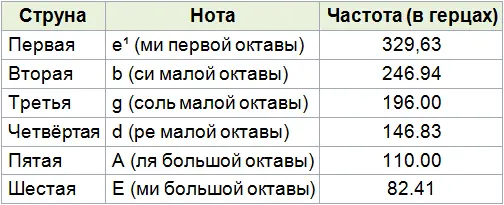
reduced action
lower tunings is a tuning at which the strings give a sound lower than the standard.
How to lower the tuning of a guitar
Very simple – guitar string tuning should go down. That is, you simply tune the instrument so that it sounds a tone or more lower than the standard tuning.
Build Drop D (Drop D)

A basic drop tuning in which the sixth string drops a tone lower. The designation looks like this: DADGBE. This tuning is used in a huge amount of music – for example, it is used by Linkin Park and many other famous bands.

Sound example
Build Drop C

Essentially the same as Drop D, only the strings drop another tone. The markup is as follows – CGCFAD. Teams such as Converge, All That Remains play in this system. Drop C is a very popular tuning in metal, and especially in core music.
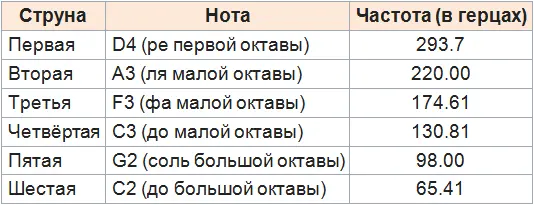
Sound example
Double Drop-D

This setting was often used by Neil Young. It looks like a regular Drop D, but the first string is tuned in an octave from the sixth. In this way, it becomes easier to play fingerpicks that require simultaneous action of the sixth and first strings.
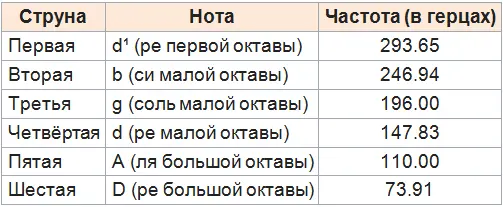
DISCHARGE

A lowered tuning, which differs in that the strings do not have a third to each other, which makes it more convenient to play modal music. Thus, it is very convenient to play violin and bagpipe parts, translating them to the guitar.

Sound example
Low tuning strings
It is also worth mentioning which strings are better for low tunings. The answer is simple – thicker than usual. The standard thickness of 10-46 will no longer be enough for ultra-low settings like the Drop B. So go for a thicker one that will give it enough tension. Usually it is written on the packs for which tuning the strings are optimal, but in general, you can deviate from this designation by a couple of tones.
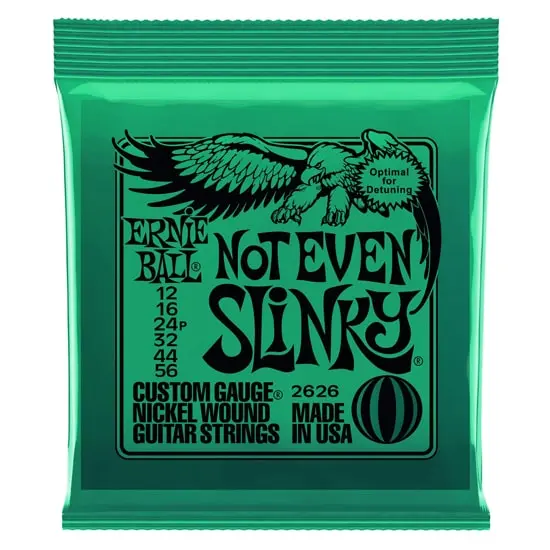
Open tunings of the guitar
Open D

This tuning forms a D major chord when played on open strings. It looks like this: DADF#AD. Thanks to this setup, it is much more convenient to play some chords, as well as play positions from the barre.
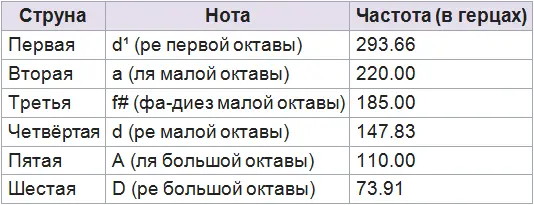
Sound example
Open G action

By analogy with Open D, the open strings here sound like a G major chord. This system looks like this – DGDGBD. In this system plays his songs, for example, Alexander Rosenbaum.
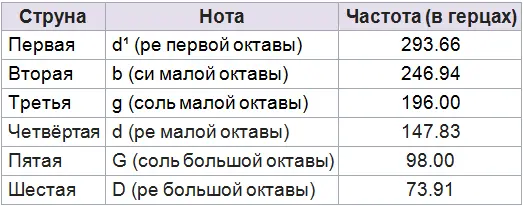
Sound example
Open C

Actually, the same as the tunings described above – with this tuning, open strings give a C chord. It looks like this – CGCGCE.
Raised tunings
There are also raised tunings – when the standard tuning rises a few tones. It is worth saying that this is very dangerous for both the guitar and the strings, since increasing the tension can deform the neck, as well as cause the strings to break. It is recommended to use thinner strings or a capo.
Safe tuning up with a capo
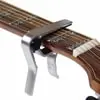
Capo for guitar – a great solution if you need to increase the system. With it, you can change it without undue tension by clamping the strings at any fret.
What you need to know when changing the tuning on the guitar

All alternative guitar tunings
Below is a table listing all existing guitar tunings. However, nothing prevents you from trying to come up with something of your own by tuning the guitar to your liking.
| Name | String numbers and note symbols | |||||
| 6 | 5 | 4 | 3 | 2 | 1 | |
| Standard | e1 | a1 | d2 | g2 | b2 | e3 |
| Drop D | d1 | a1 | d2 | g2 | b2 | e3 |
| Half Step Down | d#1 | g#1 | c#2 | f#2 | a#2 | d#3 |
| Full Step Down | d1 | g1 | c2 | f2 | a2 | d3 |
| 1 and 1/2 Steps Down | c#1 | f#1 | b1 | e2 | g#2 | c#3 |
| Double Drop D | d1 | a1 | d2 | g2 | b2 | d3 |
| Drop C | c1 | g1 | c2 | f2 | a2 | d3 |
| Drop C# | c#1 | g#1 | c#2 | f#2 | a#2 | d#3 |
| Drop B | b0 | f#1 | b1 | e2 | g#2 | c#3 |
| Drop A# | a#0 | f1 | a#1 | d#2 | g2 | c3 |
| Drop A | a0 | e1 | a1 | d2 | f#2 | b2 |
| Open D | d1 | a1 | d2 | f#2 | a2 | d3 |
| Open D Minor | d1 | a1 | d2 | f2 | a2 | d3 |
| Open G | d1 | g1 | d2 | g2 | b2 | d3 |
| Open G Minor | d1 | g1 | d2 | g2 | a#2 | d3 |
| Open C | c1 | g1 | c2 | g2 | c3 | e3 |
| Open C# | c#1 | f#1 | b2 | e2 | g#2 | c#3 |
| Open C Minor | c1 | g1 | c2 | g2 | c3 | d#3 |
| Open E7 | e1 | g#1 | d2 | e2 | b2 | e3 |
| Open E Minor7 | e1 | b1 | d2 | g2 | b2 | e3 |
| Open G Major7 | d1 | g1 | d2 | f#2 | b2 | d3 |
| Open A Minor | e1 | a1 | e2 | a2 | c3 | e3 |
| Open A Minor7 | e1 | a1 | e2 | g2 | c3 | e3 |
| Open E | e1 | b1 | e2 | g#2 | b2 | e3 |
| Open A | e1 | a1 | c#2 | e2 | a2 | e3 |
| C Tuning | c1 | f1 | a#1 | d#2 | g2 | c3 |
| C# Tuning | c#1 | f#1 | e2 | g#2 | c#3 | |
| Bb Tuning | a#0 | d#1 | g#1 | c#2 | f2 | a#2 |
| A to A (Baritone) | a0 | d1 | g1 | c2 | e2 | a2 |
| D A D D D D | d1 | a1 | d2 | d2 | d3 | d3 |
| C G D G B D | c1 | g1 | d2 | g2 | b2 | d3 |
| C G D G B E | c1 | g1 | d2 | g2 | b2 | e3 |
| D A D E A D | d1 | a1 | d2 | e2 | a2 | d3 |
| D G D G A D | d1 | g1 | d2 | g2 | a2 | d3 |
| Open Dsus2 | d1 | a1 | d2 | g2 | a2 | d3 |
| Open Gsus2 | d1 | g1 | d2 | g2 | c3 | d3 |
| G6 | d1 | g1 | d2 | g2 | b2 | e3 |
| Modal G | d1 | g1 | d2 | g2 | c3 | d3 |
| overtone | c2 | e2 | g2 | a#2 | c3 | d3 |
| pentatonic | a1 | c2 | d2 | e2 | g2 | a3 |
| Minor Third | c2 | d#2 | f#2 | a2 | c3 | d#3 |
| Major Third | c2 | e2 | g#2 | c3 | e3 | g#3 |
| All Fourths | e1 | a1 | d2 | g2 | c3 | f3 |
| Augmented Fourths | c1 | f#1 | c2 | f#2 | c3 | f#3 |
| Slow Motion | d1 | g1 | d2 | f2 | c3 | d3 |
| Admiral | c1 | g1 | d2 | g2 | b2 | c3 |
| Buzzard | c1 | f1 | c2 | g2 | a#2 | f3 |
| Face | c1 | g1 | d2 | g2 | a2 | d3 |
| Four and Twenty | d1 | a1 | d2 | d2 | a2 | d3 |
| Ostrich | d1 | d2 | d2 | d2 | d3 | d3 |
| Capo 200 | c1 | g1 | d2 | d#2 | d3 | d#3 |
| Balalaika | e1 | a1 | d2 | e2 | e2 | a2 |
| Charango | g1 | c2 | e2 | a2 | e3 | |
| Cittern One | c1 | f1 | c2 | g2 | c3 | d3 |
| Cittern Two | c1 | g1 | c2 | g2 | c3 | g3 |
| Dobro | g1 | b1 | d2 | g2 | b2 | d3 |
| Lefty | e3 | b2 | g2 | d2 | a1 | e1 |
| mandoguitar | c1 | g1 | d2 | a2 | e3 | b3 |
| Rusty cage | b0 | a1 | d2 | g2 | b2 | e3 |




